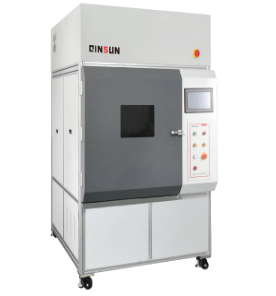- Qinsun Instruments Co., Ltd.
- Tell:+86-21-6780 0179
- Phone:+86-17740808215
- Address:No. 2578 Minhang District Gu Dai Road, Shanghai
- Contact:Mr. Li
- QQ:846490659
Si80 carbon arc aging testing machine

Carbon arc aging tester:
Material aging and fading performance test
The SI80 carbon arc aging tester uses an alternating current to light the carbon rod, generating an arc to emit light. After passing through a filter, the light source has a higher radiation energy than sunlight, which can accelerate the aging of the sample when irradiated on its surface. At the same time, due to the equipped spray device, in addition to simulating sunlight, it can also simulate rain environments, which can be well tested for the weather resistance performance of samples through the acceleration method.
SI80 carbon arc aging tester:
1. In daily use, materials may be exposed to outdoor sunlight, behind glass windows or indoor artificial light for a long time or be wet by rain, causing changes in physical properties such as fading, yellowing or strength. We call it natural aging, in order to evaluate the anti-aging performance of materials more quickly than natural aging tests.
2. An electric light source that generates a discharge arc and emits light when two carbon rod electrodes in contact are energized and separated in the air. It is the core component of carbon arc type weather resistant equipment, consisting of 4 pairs of carbon rods at the top and bottom, with thicker carbon rods on the top and thinner carbon rods on the bottom. Surrounding the carbon rod level is the filter, and the carbon arc lamp light source produces light in various wavelength bands similar to sunlight after passing through the filter, radiating to the surface of the test sample. And the distance between the upper and lower carbon rods is controlled by the carbon rod moving up and down driving device, ensuring that the carbon arc voltage and current are stable within the standard error range.
SI80 carbon arc aging tester? Domain application:
The SI80 carbon arc aging tester is widely used in industries such as plastics, paint coatings, inks, packaging, automotive materials, photochemical materials, pigments and dyes, and textiles.
The instrument is also suitable for performance verification of new products in research and development, quality control in production departments, third-party testing institutions, laboratory product performance verification, quality and technical supervision departments, etc., to determine material properties.
Compliant with standards:
JIS A1415 B7753 D0205
G3312;
H86885; K2246 K5400; Z9117;
ISO4892-1;
ASTM G23;
AATCC; NCCA





